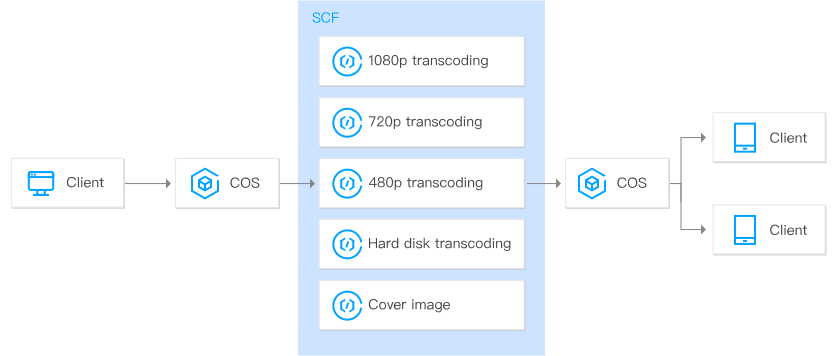
Serverless Cloud Function
A secure, stable, easy-to-use and efficient serverless function computing platform with high cost performance.
Overview
Tencent Cloud's Serverless Cloud Function (SCF) is a serverless execution environment that enables you to build and run applications without having to purchase and manage servers. Simply code in a supported language and set the execution conditions, and your code can be run on the Tencent Cloud infrastructure elastically and securely. SCF is an ideal computing platform for use cases such as real-time file processing and data processing.
Benefits
Ease of Use
High Efficiency
High Stability and Reliability
Simplified Management
Reduced Overhead
Features
Once the code is uploaded, SCF can provide you with a variety of code management methods:
You can edit the code through the console. This method is suitable for business code with no external dependencies which can be edited directly in the console.
You can zip together all the dependencies and the code and upload the zipped package to SCF. The SCF platform will automatically extract and execute the entry function.
You can zip together all the dependencies and the code, upload the zipped package to Tencent Cloud Object Storage (COS) and specify the bucket and file object where the code resides in SCF. The SCF platform will automatically download the function code.
SCF supports a variety of development environments, so you can choose the development language that suits your needs when writing the functions. At present, the following languages are supported: Python 2.7 & 3.6, Node.js 6.10 and Java 8.
Once the code is uploaded, SCF can provide you with a variety of code management methods: SCF supports the setting of multiple triggers to determine when the code should be executed. When a trigger condition (event) is met, the code automatically starts running, and infrastructure resources are automatically scheduled for auto-scaling and reclaiming based on the volume of requests, which can significantly improve computational efficiency.
Currently, the following triggers are supported:
Cloud Object Storage (COS): SCF can be triggered when files are uploaded to or deleted from specific COS buckets. More operations can be performed on the files. For example, when an image is uploaded to a specific bucket, it will be compressed or cropped to fit mobile devices with different resolutions.
Timer: SCF can be triggered by a timer, so you can build a more flexible automatic control system.
Manual trigger: SCF can be manually triggered through the cloud API/console, so you can debug and use SCF with more convenience and transparency.
CMQ topic queue trigger: SCF can be triggered by messages in the CMQ topic queue where the CMQ message queue is used to decouple the event, helping you connect to more applications.
- Code Management
- Multiple Development Environments Supported
- Automatic Scaling
- Event Triggers
- Monitoring and Logging
Once the code is uploaded, SCF can provide you with a variety of code management methods:
You can edit the code through the console. This method is suitable for business code with no external dependencies which can be edited directly in the console.
You can zip together all the dependencies and the code and upload the zipped package to SCF. The SCF platform will automatically extract and execute the entry function.
You can zip together all the dependencies and the code, upload the zipped package to Tencent Cloud Object Storage (COS) and specify the bucket and file object where the code resides in SCF. The SCF platform will automatically download the function code.
Scenarios

- Real-time File Processing
- Data ETL Processing
- Backends of Mobile and Web Applications
- AI Inference and Prediction

